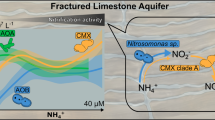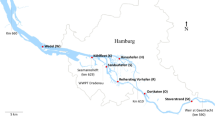Abstract
Nitrification and denitrification are key steps in nitrogen (N) cycling. The coupling of these processes, which affects the flow of N in ecosystems, requires close interaction of nitrifying and denitrifying microorganisms, both spatially and temporally. The diversity, temporal and spatial variations in the microbial communities affecting these processes was examined, in relation to N cycling, across 12 sites in the Fitzroy river estuary, which is a turbid subtropical estuary in central Queensland. The estuary is a major source of nutrients discharged to the Great Barrier Reef near-shore zone. Measurement of nitrogen fluxes showed an active denitrifying community during all sampling months. Archaeal ammonia monooxygenase (amoA of AOA, functional marker for nitrification) was significantly more abundant than Betaproteobacterial (β-AOB) amoA. Nitrite reductase genes, functional markers for denitrification, were dominated by nirS and not nirK types at all sites during the year. AOA communities were dominated by the soil/sediment cluster of Crenarchaeota, with sequences found in estuarine sediment, marine and terrestrial environments, whereas nirS sequences were significantly more diverse (where operational taxonomic units were defined at both the threshold of 5% and 15% sequence similarity) and were closely related to sequences originating from estuarine sediments. Terminal-restriction fragment length polymorphism (T-RFLP) analysis revealed that AOA population compositions varied spatially along the estuary, whereas nirS populations changed temporally. Statistical analysis of individual T-RF dominance suggested that salinity and C:N were associated with the community succession of AOA, whereas the nirS-type denitrifier communities were related to salinity and chlorophyll-α in the Fitzroy river estuary.
Similar content being viewed by others
Log in or create a free account to read this content
Gain free access to this article, as well as selected content from this journal and more on nature.com
or
References
Abell GCJ, McOrist AL . (2007). Assessment of the diversity and stability of faecal bacteria from healthy adults using molecular methods. Microbial Ecol Health Dis 19: 229–240.
Anderson MJ, Gorley RN, Clarke KR . (2008). PERMANOVA+ for PRIMER: Guide to Software and Statistical Methods. Primer-E: Plymouth, UK.
Beman JM, Francis CA . (2006). Diversity of ammonia-oxidizing archaea and bacteria in the sediments of a hypernutrified subtropical estuary: Bahia del Tobari, Mexico. Appl Environ Microbiol 72: 7767–7777.
Bernhard AE, Donn T, Giblin AE, Stahl DA . (2005). Loss of diversity of ammonia-oxidizing bacteria correlates with increasing salinity in an estuary system. Environ Microbiol 7: 1289–1297.
Braker G, Fesefeldt A, Witzel K-P . (1998). Development of PCR primer systems for amplification of nitrite reductase genes (nirK and nirS) to detect denitrifying bacteria in environmental samples. Appl Environ Microbiol 64: 3769–3775.
Caffrey JM, Bano N, Kalanetra K, Hollibaugh JT . (2007). Ammonia oxidation and ammonia-oxidizing bacteria and archaea from estuaries with differing histories of hypoxia. ISME J 1: 660–662.
Cebron A, Berthe T, Garnier J . (2003). Nitrification and nitrifying bacteria in the lower Seine river and estuary (France). Appl Environ Microbiol 69: 7091–7100.
Cook PL . (2002). Carbon and Nitrogen Cycling on the Intertidal Mudflats in a Temperate Australian Estuary. PhD Thesis, University of Tasmania, Hobart, Tasmania, Australia.
Dalsgaard T, Nielsen LP, Brotas V, Viaroli P, Underwood G, Nedwell DB et al.(eds) (2000). Protocol Handbook for NICE—Nitrogen Cycling in Estuaries: A Project Under the EU Research Program: Marine Science and Technology (MAST III). National Environmental Research Institute, Silkeborg, Denmark. pp 62.
Dang H, Zhang X, Sun J, Li T, Zhang Z, Yang G . (2008). Diversity and spatial distribution of sediment ammonia-oxidizing crenarchaeota in response to estuarine and environmental gradients in the Changjiang Estuary and East China Sea. Microbiology 154: 2084–2095.
Eyre BD, Twigg C . (1997). Nutrient behaviour during post-flood recovery of the Richmond River Estuary, northern NSW, Australia. Estuarine Coast Shelf Sci 44: 311–326.
Falk S, Hannig M, Gliesche C, Wardenga R, Köster M, Jurgens K et al. (2007). nirS-containing denitrifier communities in the water column and sediment of the Baltic Sea. Biogeosciences 4: 255–268.
Francis CA, O'Mullan GD, Ward BB . (2003). Diversity of ammonia monooxygenase (amoA) genes across environmental gradients in Chesapeake Bay sediments. Geobiology 1: 129–140.
Francis CA, Roberts KJ, Beman JM, Santoro AE, Oakley BB . (2005). Ubiquity and diversity of ammonia-oxidizing archaea in water columns and sediments of the ocean. Proc Natl Acad Sci USA 102: 14683–14688.
Fulweiler RW, Nixon SW, Buckley BA, Granger SL . (2008). Net sediment N2 fluxes in a coastal marine system—experimental manipulations and a conceptual model. Ecosystems 11: 1168–1180.
Hallin S, Lindgren P-E . (1999). PCR detection of genes encoding nitrite reductase in denitrifying bacteria. Appl Environ Microbiol 65: 1652–1657.
Hatzenpichler R, Lebedeva EV, Spieck E, Stoecker K, Richter A, Daims H et al (2008). A moderately thermophilic ammonia-oxidizing crenarchaeote from a hot spring. Proc Natl Acad Sci USA 105: 2134–2139.
He JZ, Shen JP, Zhang LM, Zhu YG, Zheng YM, Xu MG et al (2007). Quantitative analyses of the abundance and composition of ammonia-oxidizing bacteria and ammonia-oxidizing archaea of a Chinese upland red soil under long-term fertilization practices. Environ Microbiol 9: 2364–2374.
Jayakumar DA, Francis CA, Naqvi SWA, Ward BB . (2004). Diversity of nitrite reductase genes in the denitrifying water column of the coastal Arabian Sea. Aquat Microb Ecol 34: 69–78.
Junier P, Junier T, Witzel KP . (2008). TRiFLe, a program for in silico terminal restriction fragment length polymorphism analysis with user-defined sequence sets. Appl Environ Microbiol 74: 6452–6456.
Kenkel NC, Orloci L . (1986). Applying metric and nonmetric multidimensional scaling to some ecological studies: some new results. Ecology 67: 919–928.
Konneke M, Bernhard AE, de la Torre JR, Walker CB, Waterbury JB, Stahl DA . (2005). Isolation of an autotrophic ammonia-oxidizing marine archaeon. Nature 437: 543–546.
Lam P, Jensen MM, Lavik G, McGinnis DF, Müller B, Schubert CJ et al. (2007). Linking crenarchaeal and bacterial nitrification to anammox in the Black Sea. Proc Natl Acad Sci USA 104: 7104–7109.
Lamb AL, Wilson GP, Leng MJ . (2006). A review of coastal palaeoclimate and relative sea-level reconstructions using Delta13C and C/N ratios in organic material. Earth Sci Rev 75: 29–57.
Leininger S, Urich T, Schloter M, Schwark L, Qi J, Nicol GW et al. (2006). Archaea predominate among ammonia-oxidizing prokaryotes in soils. Nature 442: 806–809.
Ludwig W, Strunk O, Westram R, Richter L, Meier H, Yadhukumar et al. (2004). ARB: a software environment for sequence data. Nucl Acids Res 32: 1363–1371.
Minchin PR . (1987). An evaluation of the relative robustness of techniques for ecological ordination. Plant Ecol 69: 89–107.
Mosier AC, Francis CA . (2008). Relative abundance and diversity of ammonia-oxidizing archaea and bacteria in the San Francisco Bay estuary. Environ Microbiol 10: 3002–3016.
Nicholls JC, Trimmer M . (2009). Widespread occurrence of the anammox reaction in estuarine sediments. Aquat Microb Ecol 55: 105–113.
Nicol GW, Leininger S, Schlepe C, Prosser JI . (2008). The influence of soil pH on the diversity, abundance and transcriptional activity of ammonia oxidizing archaea and bacteria. Environ Microbiol 10: 2966–2978.
Nielsen K, Nielsen LP, Rasmussen P . (1995). Estuarine nitrogen retention independently estimated by the denitrification rate and mass balance methods: a study of Norsminde Fjord, Denmark. Mar Ecol Prog Ser 119: 275–283.
Nogales B, Timmis KN, Nedwell DB, Osborn AM . (2002). Detection and diversity of expressed denitrification genes in estuarine sediments after reverse transcription-PCR amplification from mRNA. Appl Environ Microbiol 68: 5017–5025.
Oakley BB, Francis CA, Roberts KJ, Fuchsman CA, Srinivasan S, Staley JT . (2007). Analysis of nitrite reductase (nirK and nirS) genes and cultivation reveal depauperate community of denitrifying bacteria in the Black Sea suboxic zone. Environ Microbiol 9: 118–130.
Park S-J, Park B-J, Rhee S-K . (2008). Comparative analysis of archaeal 16S rRNA and amoA genes to estimate the abundance and diversity of ammonia-oxidizing archaea in marine sediments. Extremophiles 12: 605–615.
Philippot L, Hallin S . (2005). Finding the missing link between diversity and activity using denitrifying bacteria as a model functional community. Curr Opin Microbiol 8: 234–239.
Rotthauwe JH, Witzel KP, Liesack W . (1997). The ammonia monooxygenase structural gene amoA as a functional marker: molecular fine-scale analysis of natural ammonia-oxidizing populations. Appl Environ Microbiol 63: 4704–4712.
Sahan E, Muyzer G . (2008). Diversity and spatio-temporal distribution of ammonia-oxidizing Archaea and Bacteria in sediments of the Westerschelde estuary. FEMS Microbiol Ecol 64: 175–186.
Saitou N, Nei M . (1987). The neighbor-joining method: a new method for reconstructing phylogenetic trees. Mol Biol Evol 4: 406–425.
Santoro AE, Francis CA, de Sieyes NR, Boehm AB . (2008). Shifts in the relative abundance of ammonia-oxidizing bacteria and archaea across physicochemical gradients in a subterranean estuary. Environ Microbiol 10: 1068–1079.
Schloss PD, Handelsman J . (2005). Introducing DOTUR, a computer program for defining operational taxonomic units and estimating species richness. Appl Environ Microbiol 71: 1501–1506.
Smith CJ, Nedwell DB, Dong LF, Osborn AM . (2007). Diversity and abundance of nitrate reductase genes (narG and napA), nitrite reductase genes (nirS and nrfA), and their transcripts in estuarine sediments. Appl Environ Microbiol 73: 3612–3622.
Stehr G, Böttcher B, Dittberner P, Rath G, Koops H-P . (1995). The ammonia-oxidizing nitrifying population of the River Elbe estuary. FEMS Microbiol Ecol 17: 177–186.
Steingruber SM, Friedrich J, Gächter R, Wehrli B . (2001). Measurement of denitrification in sediments with the 15N isotope pairing technique. Appl Environ Microbiol 67: 3771–3778.
Verardo DJ, Froelich PN, Mcintyre A . (1990). Determination of organic-carbon and nitrogen in marine-sediments using the Carlo-Erba-Na-1500 analyzer. Deep Sea Res A 37: 157–165.
Webster IT, Ford PW, Tillman P . (2005). Estimating nutrient budgets in tropical estuaries subject to episodic flows. Mar Pollut Bull 51: 165–173.
Weaver RW, Danso SKA . 1994. Dinitrogen fixation. In: Weaver RW, Angle JS, Bottomley PJ (eds). Methods of Soil Analysis, Part 2. Soil Science Society of America: Madison, WI. pp 1019–1045.
Wuchter C, Abbas B, Coolen MJL, Herfort L, van Bleijswijk J, Timmers P et al. (2006). Archaeal nitrification in the ocean. Proc Natl Acad Sci USA 103: 12317–12322.
Zumft WG . (1997). Cell biology and molecular basis of denitrification. Microbiol Mol Biol Rev 61: 533–616.
Acknowledgements
We thank the Office of the Chief Executive, CSIRO for the award of an OCE postdoctoral fellowship to G Abell. Lesley Clementson (CSIRO Marine and Atmospheric Research) is thanked for chlorophyll analyses and Steve Wakelin (CSIRO Land and Water) is thanked for critiquing the paper.
Author information
Authors and Affiliations
Corresponding author
Additional information
Supplementary Information accompanies the paper on The ISME Journal website (http://www.nature.com/ismej)
Supplementary information
Rights and permissions
About this article
Cite this article
Abell, G., Revill, A., Smith, C. et al. Archaeal ammonia oxidizers and nirS-type denitrifiers dominate sediment nitrifying and denitrifying populations in a subtropical macrotidal estuary. ISME J 4, 286–300 (2010). https://doi.org/10.1038/ismej.2009.105
Received:
Revised:
Accepted:
Published:
Issue date:
DOI: https://doi.org/10.1038/ismej.2009.105
Keywords
This article is cited by
-
The contribution of nirK gene-containing thaumarchaea to denitrification and N2O production across coastal sediment and terrestrial ecosystems
Journal of Soils and Sediments (2022)
-
Removal Capacities and Environmental Constrains of Denitrification and Anammox Processes in Eutrophic Riverine Sediments
Water, Air, & Soil Pollution (2020)
-
nirS-type denitrifying bacterial communities in relation to soil physicochemical conditions and soil depths of two montane riparian meadows in North China
Environmental Science and Pollution Research (2020)
-
NirS-type N2O-producers and nosZ II-type N2O-reducers determine the N2O emission potential in farmland rhizosphere soils
Journal of Soils and Sediments (2020)
-
Distinct distribution patterns of ammonia-oxidizing archaea and bacteria in sediment and water column of the Yellow River estuary
Scientific Reports (2018)



